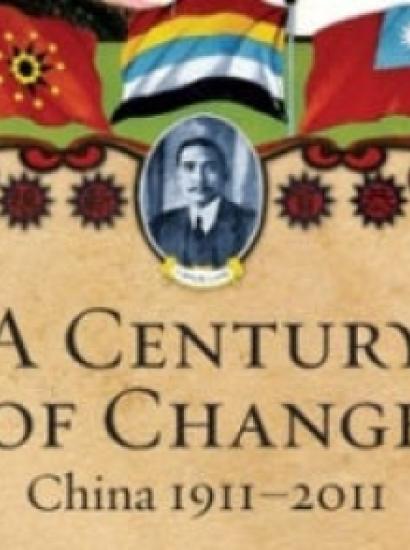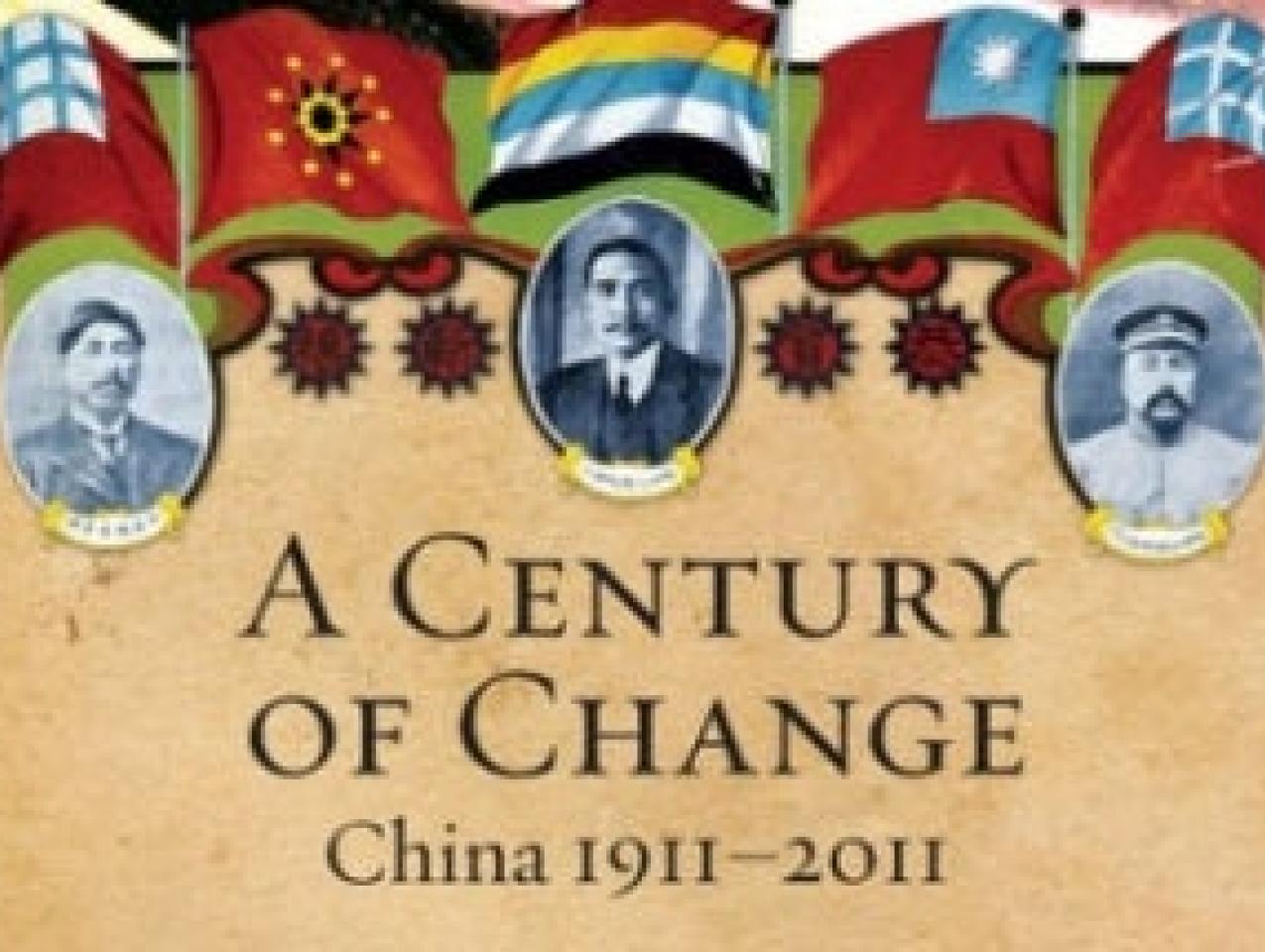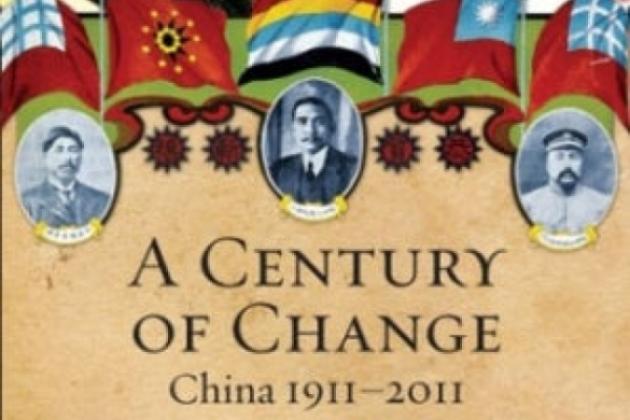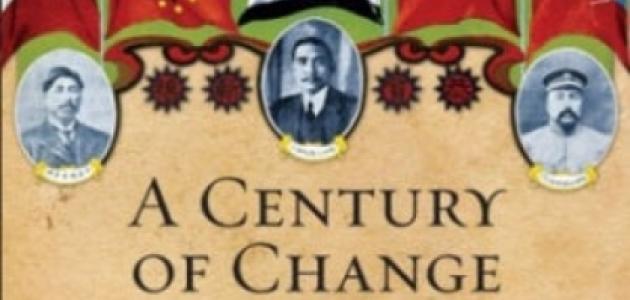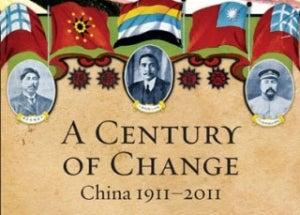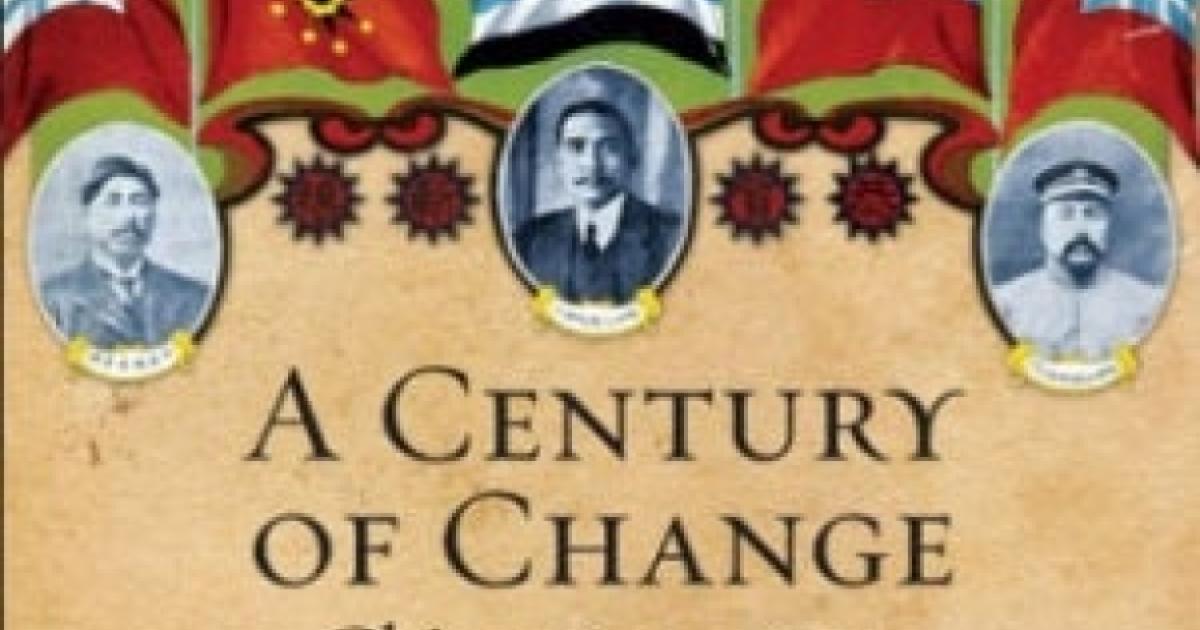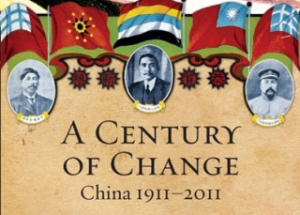
On April 12, 2011, the Hoover Institution commemorated the hundredth anniversary of the 1911 revolution and the founding of the Chinese republic with the opening of an exhibition of photographs, posters, letters, memorabilia, and audiovisual materials from its library and archives, documenting those momentous events in Chinese history and the ensuing tumultuous century. This exhibit is closed.
Click here to see past exhibits related to East Asia.
Read an article about the exhibit, published in Hoover Digest.
- PREFACE / 序言
- INTRODUCTION AND ACKNOWLEDGMENTS / 謝辭
- THE EMPIRE AND ITS DISCONTENTS / 滿清傾覆前的局勢
- REFORMERS AND REVOLUTIONARIES / 革命與立憲的對峙
- THE WUCHANG UPRISING AND THE FALL OF A DYNASTY / 武昌起義與滿清覆亡
- THE BIRTH OF A REPUBLIC / 民國肇建
- THE WARLORD ERA AND THE FIRST UNITED FRONT / 軍閥割據與第一次國共合作
- THE SINO-JAPANESE WAR AND THE SECOND UNITED FRONT / 對日抗戰與第二次國共合作
- THE CIVIL WAR AND THE DIVIDED CHINA ISSUE / 國共內戰與兩岸分治
- HOOVER'S COLLECTING HISTORY / 百年來胡佛研究所的檔案收藏
Preface
In the United States, one hundred years is a very long time; in the history of China, it is the blink of an eye. Although relatively adolescent in the long scope of Chinese history, the one hundred years of the Chinese republic are being commemorated by the Hoover Institution with a display of treasures and historical artifacts from the Hoover Institution Archives. Although far from a definitive history of China's last one hundred years, the exhibition, A Century of Change: China 1911–2011, provides a glimpse of China from our collections.
The decision to mount this exhibition was not a hard one; there has long been a strong connection between Hoover and China. At the turn of the twentieth century, President Herbert Hoover, the Institution's founder, and his wife, Lou Henry Hoover, lived and worked in China. While in China, President Hoover, never one to shy away from hard work, immersed himself in the study of Mandarin and is said to be the only US president to speak Mandarin.
The Hoover Institution Archives is proud of its Chinese collections, which have expanded greatly in the last decade; decisions on which materials to display, however, were difficult. Although much was left behind, we feel that the exhibition and this catalog contain a representative sample of our holdings.
The exhibition includes vintage videos from Sun Yat-sen's funeral, Generalissimo Chiang Kai-shek's and General Joseph Stilwell's original diaries, and the art of Huang Zhen from Mao's Long March. In addition to the grand historical images of China, less well known stories (those that make the Hoover Institution Archives unique) are included—they complement and complete the history of the past one hundred years. We were sometimes surprised in our research; for example, within the files of one collection were two seemingly innocuous pamphlets that, when unfolded, revealed a nine-foot illustration of Sun Yat-sen's 1929 state funeral procession and a rare map depicting the procession route of his sarcophagus through Beijing.
The catalog and the exhibition commemorate, in a small way, what the Chinese people have accomplished and acknowledge the work of the scores of curators, scholars, students, soldiers, travelers, friends, and donors who have helped the Hoover Institution Archives document China’s history for the scores of scholars who will follow.
We all owe a great debt of gratitude to the Hoover Institution Archives Asian curators Lisa Nguyen and Hsiao-ting Lin, who selected the material for the exhibition and tirelessly worked their way through thousands of ephemera to select those that you see. Nick Siekierski, Hoover’s exhibition coordinator, lent his experienced eye to help determine what best characterizes Hoover’s collections. Wang Li's translations make this truly a joint Chinese-American endeavor.
The republic's founding predates the founding of the Hoover Institution; we expect the republic to endure and the Hoover Institution to endure. For our part, we will continue to collect materials related to Chinese history, politics, and culture and continue to look to China as a friend and partner as we plan for the two hundredth anniversary of the founding of the republic.
Richard Sousa
Director of the Hoover Institution Library and Archives
序言
一百年的長度,對美國歷史而言,是一段不小的進程,然而對具有數千年歷史的中國而言,卻只是彈指瞬間,與 中國的歷史巨流相比,美國顯得相對年輕。儘管如此,史丹佛大學胡佛研究所極其榮幸,能以「世紀之變:辛亥 百年珍藏史料展」為題,以胡佛檔案館所藏之珍貴史料與文物,來紀念辛亥革命與民國肇建一百周年。
此次舉辦展覽,實情理之中之事; 2011 年是中國近代史上的一個重要里程碑,而本研究所的創始者、美國第三 十一任總統胡佛,與中國之間又有著極為深厚的聯結;十九世紀的最後數年歲月裡,甫自史丹佛大學畢業不久的 胡佛,偕其夫人露亨利,前往中國天津工作與生活,並曾遇上庚子拳亂。在華期間,胡佛夫婦辛勤工作,並努力 學習中文,據知,胡佛也是迄今唯一一位會說中文的美國總統,他在天津時努力學習中文的照片,也在此次展覽 中陳列出來。
胡佛檔案館向來對近代中國深厚與豐富的史料收藏,引以為豪,過去十年來,我們在這方面更有著極大的突破。 受限於展覽空間有限,展出史料與文物的挑選,反成了困難之事。本次展覽,我們致力於呈現近代中國社會、政 治、文化與藝術等豐富面向,以及其歷史變遷,儘管獲選展出的材料僅占胡佛整體館藏的一小部分,我們仍希望 透過此次展覽與目錄集的出版,讓世人瞭解胡佛近代中國館藏的廣度、深度與多樣性。
此次展覽與目錄出版,雖然無法精細與完整地涵蓋中國過去百年來的歷史滄桑,然而透過精心策劃的史料展覽, 我們依然得以讓世人對於這段歷史,領略一二:我們展出了廣為人所知、卻鮮為人所見的孫中山奉安典禮完整記 錄片,我們也展出蔣介石與史迪威將軍的日記原件、與紅軍長征時期黃鎮的素描畫作等等。籌備此次展覽的過程 中,有時會出現意外的驚喜與發現。例如,我們在某一份私人檔案裡,有兩份乍看並不起眼的小冊子,打開後赫 然發現一份是一極為罕見的地圖,描繪了 1929 年 北京城內孫中山的移靈路線,另一份則是同年所發行、九尺大 小的圖示,內容描述當年南京城內隆重舉辦孫中山奉安典禮的遊行序列。
本目錄集的出版與本次史料展,在一定程度上,呈現了百年來中國人民業已走過的歷程,同時也是許多專家前輩 們辛苦的結晶;若沒有過去曾經踏上中國土地、為收集史料而努力的胡佛檔案收藏家與管理者、學者、學生、士 兵、旅行者與朋友們,以及胡佛檔案館的眾多檔案捐贈者們的貢獻與辛勞,此次的展覽就無法如此順利舉行,而 來自全球各地的學者們,恐怕也就無法從事相關研究。
我們要對胡佛檔案館亞洲館藏部門的兩位負責人林孝庭與阮秋芳,表達最深沉的感謝之意。他們為本次展覽選 取材料,不辭辛勞地在數以萬計的故紙堆中,精挑細選出這些珍貴文物,讓參訪者一飽眼福;檔案館展覽協調員 Nick Siekierski 在籌備過程中, 協助兩位亞洲館藏負責人,運用其豐富的經驗協同策劃,將胡佛檔案館藏的特 質,做出最佳的呈現。王麗協助將展覽的英文解說以及本目錄集的英文內容,翻譯成中文,故此次盛宴真可謂是 中、美合力之作。
辛亥革命與民國肇建,早於胡佛研究所的創立,我們希望民國永存,並以此促進胡佛研究所的蓬勃發展與永續經 營。就胡佛研究所的立場而言,我們將繼續視中國為朋友與夥伴,希冀搜集與中國歷史、政治和文化等各方面相 關的資料。讓我們衷心期盼,在下一個世紀,舉辦辛亥革命與民國肇建兩百周年的紀念活動。
胡佛檔案館暨圖書館館長 理查蘇颯
Introduction and Acknowledgments
The year 2011 marks the one-hundredth anniversary of the Chinese Revolution, also known as the Xinhai Revolution (1911). The revolution was triggered by corruption in the Qing imperial court, the government's inability to restrain the interventions of foreign powers, and the majority Han Chinese’s resentment of a government dominated by the Manchu ethnic minority. On October 10, 1911, the revolution began with an uprising in Wuchang, the capital city of Hubei Province on the Yangtze River. Within months, the revolution had overthrown 268 years of Manchu autocracy–ending more than two thousand years of feudal monarchies and establishing one of Asia's first republics, the Republic of China.
The collapse of the imperial order, however, did not guarantee a smooth transition to a full-fledged democracy. In the century following, China underwent frequent and drastic upheavals in its military, politics, economics, social structure, and ideologies and continued to confront the threatening external challenges that had never ceased to exist.
In April 2011, the Hoover Institution commemorated the hundredth anniversary of the 1911 revolution and the founding of the Chinese republic with a new exhibition, A Century of Change: China 1911–2011. Drawing on the rich holdings of the Hoover Library and Archives, the exhibit offers a unique insight into those momentous events in Chinese history and the ensuing tumultuous century. More significantly, the exhibit demonstrates how, in keeping with the Institution’s mission, defined as the study of war, revolution, and peace, the Hoover Library and Archives continue to thrive and play a pioneering role in the world’s modern China collection and research.
Many individuals have contributed their assistance, time, skills, generosity, and positive energy to create A Century of Change: China 1911–2011.
Chief among them are Rachel Bauer, Brandon Burke, Rae Chang, Elizabeth Chiang, Sarah Farber, Jimmy James Fayne, Rayan Ghazal, Cissie Hill, David Jacobs, Lyalya Kharitonova, Tai-chun Kuo, Tim Laverne, Ramon Myers, George Nash, Jennifer Navarrette, Janel Quirante, Russell Rader, Jim Sam, Ellen Santiago, Maciej Siekierski, Stephanie Stewart, Celeste Szeto, Mark Tam, Adam Tow, and Tin Tin Wisniewski.
Enormous credit goes to Nick Siekierski (outreach and exhibits coordinator), who provided expert ideas and insights in the production, installation, and design of the exhibit cases and publicity materials.
A never-ending thank you to Linda Bernard (deputy archivist) who diligently read/reread and formatted texts, rendered support, and, in particular, contributed her contagious gung-ho enthusiasm throughout the months of the project.
Exhibit texts have greatly benefited from Ann Wood’s (institutional editor) keen critical eye. For their thoughtful comments, we would also like to thank Brad Bauer, Lisa Miller, and Don Young. Wang Li is gratefully thanked for translating the English text into Chinese.
Special thanks goes to Richard Sousa (director, Hoover Library and Archives), without whose vision and support this exhibit would not have been possible.
Lisa Nguyen and Hsiao-ting Lin
謝辭
今(2011)年是辛亥革命爆發的一百週年。一個世紀前的1911年,滿清王朝在中國的統治,已走到了盡頭;對內, 清政府無法解決其腐敗無能,以及滿漢兩大民族之間的矛盾對立,對外,清政府無力回應日本與西方列強對中國 的侵略與干涉。10月10日,辛亥革命在湖北武昌爆發,數月之後,革命黨人推翻了268年的清王朝,終結了中國 長達兩千餘年的封建專制體制,建立了亞洲第一個共和國——中華民國。
然而,帝國秩序的崩潰,並未能夠確保中國平穩地轉化成為民主國家。辛亥革命後的一百年間,中國在軍事、政 治、經濟、社會與意識型態各方面,依然不時出現劇烈震盪,外患從來未曾消失,而中國始終面臨生存危機。
2011年4月,史丹佛大學胡佛研究所舉辦「世紀之變--辛亥百年珍藏史料展」,紀念辛亥革命與民國肇建一百週 年。此次展覽以胡佛研究所圖書館與檔案館豐富的館藏為基礎,讓世人得以窺見近代中國彪炳史冊的重大歷史事 件,瞭解上一個世紀發生在中國這塊土地上的風雲變幻。更重要者,此一展覽,充分彰顯了胡佛圖書館和檔案館 基於研究所創建人、美國第31任總統胡佛所賦予的使命——環繞在與「戰爭」、「革命」與「和平」相關議題的 研究——在近、現代中國史料館藏與研究領域上,繼續成長茁壯,享有國際最高的聲譽。
以下人士為「世紀之變--辛亥百年珍藏史料展」與目錄冊的出版,貢獻了其時間與心力,在此我們要致上最深切 的感謝之意: Rachel Bauer, Brandon Burke, Rae Chang, Elizabeth Chiang (蔣方智怡), Sarah Farber, Jimmy James Fayne, Rayan Ghazal, Cissie Hill, David Jacobs, Lyalya Kharitonova, Tai-chun Kuo (郭岱君), Tim Laverne, Ramon Myers, George Nash, Jennifer Navarrette, Janel Quirante, Russell Rader, Jim Sam, Ellen Santiago, Maciej Siekierski, Stephanie Stewart, Celeste Szeto (房國穎), Mark Tam, Adam Tow 與 Tin Tin Wisniewski.
我們要感謝胡佛檔案館負責展覽與協調的 Nick Siekierski, 他在製作、陳列、單元設計與宣傳材料等方面,提供了 最具專業化建議。
我們由衷感謝檔案館副館長 Linda Bernard, 她屢次閱讀並修訂展覽文本,並且為展覽的排版,提供技術上的支援, 在展覽籌備期間,她始終熱情洋溢地無私奉獻。
我們要感謝研究所編輯 Ann Wood 對展覽文本的文字敘述,進行最高標準的編輯與校對。我們要向 Brad Bauer, Lisa Miller, 與 Don Young 對文本內容的審慎建議,致上謝意。王麗對英文文本進行中文翻譯,我們同樣表示感謝。
最後,我們特別要感謝胡佛研究所圖書與檔案館館長 Richard Sousa, 他的遠見、視野與支持,讓此次展覽與出版 得以順利成功。
林孝庭 阮秋芳
The Empire and Its Discontents
At the beginning of the twentieth century, China was still reeling from the Taiping Rebellion, the Opium Wars, and the first Sino-Japanese War of 1894–95. That war resulted in China’s losing Korea, Taiwan, the Pescadores, and the Liaodong region of southern Manchuria. Additional losses for China included an indemnity payment of 200 million taels and the forced opening of treaty ports.
In 1900, the antiforeigner Boxer Rebellion was led by the Yi He Quan (Righteous Harmonious Fists), on orders from the empress dowager Cixi, the de facto ruler, to “protect the country and destroy the foreigners.” Twenty thousand troops from an eight-nation alliance (Austria-Hungary, France, Germany, Italy, Japan, Russia, the United Kingdom, and the United States) defeated the resistance. In September 1901, the Qing court signed the Boxer Protocol. Again, China was forced to foot the bill–450 million taels, almost double the government’s annual income–and the eight nations would wrest even more concessions from China.
The gentry, landlords, and merchants in the provinces fought back, demanding local control of the new railways that were funded by foreign companies. They succeeded, and in 1905, as part of the Railway Rights Recovery Movement, the authority to manage the Sichuan-Hankou and Guangdong-Hankou railway lines was granted to the people of Hunan, Hubei, Sichuan, and Guangdong Provinces.
Anxious about increasing provincial autonomy, the government countered by nationalizing China’s main railways, igniting fury among the provincials, who resented the recentralization of the Qing court’s power, the loss of their private investments, and the intrusion of foreign economic influence in China. The animus against the government became violent and massive antigovernment riots spread rapidly throughout the southern provinces. Qing troops clashed with demonstrators and public order broke down.
China was also plagued by natural disasters that ruined harvests and caused widespread famine. Massive social strife, economic stagnation, military defeats, and expanded foreign concessions brought on national despair. When the empress dowager died in 1908 and the emperor Aisin Gioro Puyi, a two-year old, ascended the throne, the Qing Dynasty was on the verge of collapse.
滿清傾覆前的局勢
二十世紀初,中國仍未走出上一世紀的太平天國之亂、兩次鴉片戰爭、以及1894-1895年間中日甲午戰爭戰敗的 巨大陰影。甲午戰敗,中國失去了朝鮮半島、割讓了台灣、澎湖群島以及遼東半島。此外,中國在這些戰敗賠款 中損失了二億兩白銀,並且被迫開放各通商口岸。
1900年,義和團發起排外運動,在慈禧太后鼓勵下,義和團展開「扶清滅洋」的仇外運動,最後引發奧匈帝國、 法國、德國、意大利、日本、俄國、英國、美國等為數兩萬名的八國聯軍攻入北京城。1901年9月,清廷簽署辛 丑和約。中國再次被迫賠款四億五千萬兩白銀——這筆款項幾乎相當於清政府年收入的兩倍——而上述八個國家 也獲得更多在華特權。
與此同時,中國境內各省的士紳、地主與商人階級,面對外國在華勢力的擴張,奮力反擊,要求清廷收回外國公 司在華運營的新鐵路。1905年,「保路運動」取得部分勝利,川漢鐵路和粵漢鐵路的管理權交由湖南、湖北、四 川和廣東各省當局掌管。為避免助長各省自治傾向,清廷也開始採取鐵路國有化措施。
清政府此一措施,卻讓各省私人投資大量流失,也讓中國遭受外國經濟勢力的侵蝕,各省地方當局同時也反對清 廷再度中央集權。這種反政府的敵意,逐漸演變成為大規模暴亂,特別是在華南各省之間,快速蔓延。
清政府派軍隊鎮壓示威者,然而公共秩序也逐漸失控。此外,中國亦飽受天災與農產欠收之苦,飢荒氾濫。大量 的社會糾紛、經濟蕭條、軍事失利與外國在華特權擴展,讓整個中華民族陷於困境。 1908年,當光緒皇帝與慈禧 太后先後駕崩、兩歲的愛新覺羅·溥儀繼承皇位時,清王朝實已瀕臨崩潰邊緣。
Reformers and Revolutionaries
As discontent mounted, two opposing movements, the reformers and the revolutionaries, aimed at reviving China. The reformers, led by Kang Youwei and Liang Qichao, sought change within the confines of the imperial system and called for the reorganization of institutional and ideological policies. This short-lived movement, known as the Hundred Days Reform of 1898, proposed a series of sweeping internal changes. The emperor Guangxu, more receptive to change than the obdurate empress dowager Cixi, issued edicts for massive political, legal, and social reforms, including improving the status of women, introducing provincial assemblies at the local level, abolishing the civil service examinations, and formulating a new code of law.
Guangxu believed that, by modeling China on constitutional monarchies such as Japan, China would become politically and economically powerful. Those reforms, however, were viewed by many as too extreme for a China still heavily influenced by neo-Confucian statecraft. Cixi, seeing the changes as a serious threat to her power, condemned the Hundred Days Reform as too radical and immediately placed Guangxu under house arrest. Kang and Liang escaped to Japan. Both men continued to advocate a constitutional monarchy and raised support for their cause among overseas Chinese and foreign governments. In 1899 Kang and Liang founded the Bao Huang Hui (Save the Emperor Society), whose purpose was to depose the empress dowager Cixi and return the reformists to power.
The man who would become known as the “Father of the Republic,” Dr. Sun Yat-sen, was born into a peasant family in Guangdong Province but raised in Hawai’i, where he received a Christian education and trained as a medical practitioner. Western democratic ideals were firmly ingrained in Sun’s consciousness. Because his non-gentry status cut him off from legitimate political action in traditional China, he promulgated the overthrow of the Manchu Dynasty, not reform, to save the nation.
After he backed a failed 1895 uprising in Guangdong, Sun Yat-sen was declared a criminal with a price on his head. He then traveled around the globe, advocating revolution and soliciting financial and other support. Sun’s base was Yokohama, Japan, where he, along with Huang Xing and Song Jiaoren, founded an underground resistance movement, the Tong Meng Hui (United Alliance League), in 1905.
That new alliance was made up of Sun’s Xingzhong Hui (Revive China Society), the Guangfu Hui (Restoration Society), and other Chinese revolutionary groups. Combining republican, nationalist, and socialist objectives, Tong Meng Hui’s political platform was "Drive out the Tartars, revive China, establish a republic, and equalize land distribution."
Sun’s revolutionary upsurge forced the Qing government to institute reforms to stave off collapse. After the empress dowager’s death in 1908, the Qing regents drew up steps to be taken during a nine-year period to establish a constitutional monarchy. Although ambitious, those reforms were clearly too little, too late.
革命與立憲的對峙
面對民怨沸騰,晚清的中國政治上出現改革派和革命派兩種不同的自救運動。以康有為與梁啟超為首的改革派, 欲在既有的帝制架構內進行革新,呼籲改組政府機構並推動新的政治思維。此一改革曾於1898年短暫獲得實現, 史稱「百日維新」,改革派們提出了一系列革新措施,並獲得光緒皇帝的支持,他頒布了若干新的政令,進行法 律和社會改革,包括提高婦女地位、推動各省諮議會的成立、廢除科舉、制定新法典等。
光緒皇帝認為,此刻中國若能效仿日本實行君主立憲,將有助於實現政治和經濟上的自強。然而中國當時仍深受 新儒家治國之道的影響,許多人認為上述改革措施過於激進。慈禧太后則視這些改革為自身權力的絆腳石,視百 日維新過於極端,最後發動政變,軟禁光緒皇帝,康有為和梁啟超逃往日本。在海外,他們繼續呼籲推動中國的 君主立憲,並向海外華人與外國政府尋求支持。 1899年,康有為和梁啟超成立「保皇會」,其訴求為罷黜慈禧太 后,將權力還給光緒皇帝與改革派。
孫中山出生於廣東省一個農民家庭,在夏威夷成長,並接受了基督思想與教育,成為一名醫師,最後獻身於中國 的革命運動。他深受西方民主思想的影響,然而由於他並非出身士紳階級,無法在傳統中國帝制社會下施展政治 抱負,因而在體制外宣揚推翻滿清,欲進行「革命」而非「改革」。
1895年,孫中山在廣東策動反清起義失敗後,成為清政府的頭號罪犯。接著,他離開中國,環遊世界,尋求各方 對其革命運動的支持與援助。1905年,孫中山以日本橫濱為基地,和黃興、宋教仁等人一同發起「同盟會」。
此同盟會是由孫中山更早創立的興中會,以及光復會等其他革命團體所組成。該會的政治綱領是「驅逐韃虜、恢 復中華、創建民國、平均地權」,融合了共和國思想、民族主義與社會主義的目標。
孫中山日益升高的聲望與革命氣焰,迫使清政府尋求改革,以求自保。1908年慈禧太后與光緒帝去世後,清攝政 王曾擬定步驟,欲在九年之內建立一個君主立憲體制。儘管這些改革頗具企圖心,但顯然已無力回天。
The Wuchang Uprising and the Fall of a Dynasty
The October 10, 1911, Wuchang Uprising that led to the collapse of China’s 2,100-year-old dynastic empire literally arose out of an accident. Revolutionaries in Wuchang, Hubei Province, were building bombs, one of which inadvertently exploded, giving their plot away. Knowing they faced death if caught, they immediately set in motion military actions in south and central China that resulted in a wave of strategic victories.
Sun Yat-sen had no direct role in the Wuchang Uprising (he was traveling in the United States and read about it in a newspaper) and in fact favored an uprising in his native Guangdong. Sun’s rival in the alliance, Huang Xing, favored an uprising in central China, which he was planning for late October. Thus the revolutionary leaders were all caught off guard, leaving the mutineers without a leader.
Then Li Yuanhong, the Qing-appointed commander of the Twenty-first Mixed Brigade in Hubei, was dragged from under his bed by the mutineers and forced at gunpoint to lead the rebellion. He later became the only man ever to serve twice as president of the republican government. At first, the revolt was considered merely the latest in a series of mutinies in southern China and was widely expected to be quickly suppressed. But, because the Qing court failed to respond promptly, provincial assemblies in many southern provinces rapidly declared independence from the Qing government and allegiance to the rebellion.
As news of the success of the insurrection broke, men in urban areas sheared off their queues as a challenge to the Manchu authority. Within a month, representatives from the sixteen seceding provinces had met and declared a Republic of China. In February 1912, 268 years of Qing imperial rule came to an end when Puyi abdicated, thus becoming the last emperor of China.
武昌起義與滿清覆亡
1911年10月10日所發生的武昌起義,實為一偶發事件,卻使得中國長達兩千一百年帝制王朝宣告終結。湖北武昌 的革命軍,製造炸彈時不慎爆炸了一顆,因此洩露了秘密。他們深知,如果被捕只有死路一條,所以迅速地在華 南和華中地區發動軍事行動,最後取得一系列勝利。
孫中山並未直接參與武昌起義,當時他正在美國旅行,從報紙上得知武昌起義的消息。他向來主張在其家鄉廣東 省發動起義,他在同盟會裡的潛在對手黃興,則力主於當年十月底在華中起義。因此,當武昌起義爆發後,革命 黨人一時措手不及,造成群龍無首的局面。
清軍第二十一混成旅協統黎元洪被武昌起義者,從其床底下拉出來,並用槍口迫使他領導起義。稍後,他成為民 國總統,也是唯一一位兩度擔任此一職務的人。華南地區起義為數眾多,武昌起義最初只被清廷視為是單一事件, 大多數人也認為將很快被鎮壓下去。但是,由於清朝沒有迅速反應,南方各省的省諮議會很快宣布脫離清朝獨立, 擁護起義。
隨著武昌起義爆發並且獲致成功的消息傳播開來,鄉村地區的人們剪去辮子,對滿清統治當局發起挑戰。一個月 內,十六個脫離清廷統治的省份代表集會,宣布成立中華民國。1912年2月,中國最後一位皇帝溥儀宣布退位, 歷時二百六十八年的清王朝統治宣告終結。
The Birth of a Republic
People in the early republic were optimistic that the new China could develop into a full-fledged democracy. Those hopes seemed realized when Sun Yat-sen, accompanied by his political adviser Homer Lea, returned to Hong Kong on December 21, 1911, and was elected provisional president of the Republic of China (ROC) by representatives of the provisional assemblies in Nanjing. Li Yuanhong was appointed vice-president. Sun’s longtime associate, Huang Xing, took charge as the unofficial prime minister.
In his forty-five days as president, Sun and the provisional legislators proclaimed the establishment of the ROC, introduced a republican regime, adopted the Gregorian calendar, and replaced the imperial dragon flag with the Five Color Flag, which consisted of five horizontal stripes in red, yellow, blue, white, and black, representing China’s five major nationalities. Sun, however, recognizing that he had neither the experience nor the force of arms to rule successfully, tendered his resignation on February 15, 1912. He offered the presidency to Yuan Shikai, a military man from northern China and an experienced imperial official with some interest in reform. Sun hoped that Yuan would use his army and power to realize the goals of the new republic.
Song Jiaoren, one of the founders of the Tong Meng Hui (United Alliance League), was instrumental in transforming that organization into the Kuomintang (KMT). In China’s first nationwide election in 1912–13, he led the KMT to victory. The euphoria following that victory, however, was brief. Song spoke out against the increasing authoritarianism of President Yuan, angering Yuan, who was not about to share power with any national parliament, particularly one run by the KMT. The ambitious Yuan then hired an assassin, who killed Song Jiaoren on March 20, 1913, at the Shanghai train station. In 1915 Yuan declared himself the emperor of China in an effort to reestablish the imperial system.
民國肇建
民國肇建初始,人們普遍樂觀地認為中華民國能夠發展成為一個成熟的民主國家。 1911年12月21日,當孫中山 在其政治顧問荷馬李將軍的陪同下,從香港回到中國,並且在南京被推舉為中華民國臨時總統時,很多人是持此 種樂觀的看法。黎元洪則被任命為臨時副總統。黃興——孫中山的長期戰友,則出掌民國總理一職。
孫中山擔任臨時總統的四十五天內,新的中華民國政府採取共和政體,採用西曆、以紅、黃、藍、白、黑五色旗 取代皇龍旗成為新國旗。然而,孫中山既沒有執政經驗,也沒有足夠的武裝力量作為統治的後盾。1912年2月15 日,孫中山將總統職務讓位給袁世凱。袁世凱出身華北,是一位經驗豐富、並且對改革有一定興趣的前清政府要 員。孫中山希望袁世凱可以利用其軍隊與影響力,來實現新共和政府的各項目標。
同盟會的創始人之一宋教仁,在將同盟會整合成為國民黨的過程中,發揮了積極作用。 1912-1913年,宋教仁領 導國民黨在中國第一次舉行的全國大選中獲勝。然而國民黨勝利的果實只有曇花一現。袁世凱獨裁傾向與日俱增, 宋教仁對此公開反對,這觸怒了並不打算與國民黨所主導的國會共享權力的袁世凱。1913年3月20日,野心勃勃 的袁世凱僱用一名殺手,在上海火車站暗殺宋教仁。1915年,袁世凱復辟稱帝,帝制死灰復燃。
The Warlord Era and the First United Front
After Yuan Shikai’s death in 1916, China plunged into the warlord period, with regional military leaders ranging from local bandits’ controlling small bases to powerful heads of large armies’ controlling broad swaths of territory.
Despite the chaos, a remarkable intellectual movement was developing in the universities, where the spirit of revolution had awakened interest in political ideologies from the West. The center of activity was Peking University (PKU), whose affiliates included many founding figures of the Chinese Communist Party (CCP), in particular a littleknown library assistant, the man who would lead the peasant revolution and ultimately rule China, Mao Zedong. In May 1919, students at PKU learned of the concessions gained by Japan, including the handover of the Shandong Peninsula, as the result of the Treaty of Versailles that ended World War I. In response, the students initiated a mass demonstration that spread from city to city, igniting the general population in the largest outpouring of nationalistic fervor China had ever seen. Demanding reforms at all levels of Chinese society, the demonstration became known as the May Fourth Movement.
Meanwhile, Sun Yat-sen continued his attempts to tame the regional warlords and build a national government. After years of fruitless efforts to secure international support, Sun turned to the newly formed Soviet Russia, which was eager to gain influence in China. In 1923, Sun sent Chiang Kai-shek to Moscow to determine how Sun’s political party, the Kuomintang (KMT), and Chiang’s army could work together to regain control of China. Two Russian agents, Vasily Blücher and Mikhail Borodin, were sent to China to integrate the fledgling CCP within the ranks of the KMT, using the Soviet model. That alliance was attractive to Sun in that the Soviets would provide political training, military assistance, and financial support. The KMT and the CCP, from their base at the Whampoa Military Academy in Guangdong, began training together in 1923 in preparation for the Northern Expedition, the mission to reunite China in their first united front.
After Sun’s untimely death in 1925, his followers mounted the Northern Expedition, advancing from Guangdong to the Yangtze River Valley. The combination of Nationalists and Communists proved temporarily successful, with the Communists preparing the territories ahead of the army with propaganda, demonstrations, and strikes. When the army, led by Chiang, arrived in Shanghai, an earlier communist-led uprising of workers contributed greatly to its success. Chiang, however, had begun to resent the Soviet agents, feeling that they were more interested in the international goals of the CCP than the national goals of the KMT. In addition, the CCP’s strikes and related activities, choreographed by Stalin, alienated the middle and commercial classes, from which Chiang derived the majority of his support. On April 12, 1927, Chiang staged a successful purge of Communists in Shanghai; the few who escaped went underground.
By 1928, the Northern Expedition mission had been completed when the young Manchurian warlord Zhang Xueliang recognized the Nanjing-based Nationalist government. The goal of unifying China had been accomplished, at least nominally.
軍閥割據與第一次國共合作
1916年袁世凱去世之後,中國進入軍閥時代。各地軍閥出身背景五花八門,有的是控制著一小塊土地的強盜,有 的則是是帶領大批軍隊、割據一方的實力派領袖。
儘管當時政治局面混亂,在中國各大學校園裡還是興起了一批引人注意的知識份子,推展學生運動,其目的在於 以革命精神,喚醒國人對西方政治與意識形態的關注。這一學生運動以北京大學為中心,日後許多中國共產黨的 創始者,當時都在北大校園裡工作,包括當時鮮有人認識的北大圖書館助理毛澤東。在日後的中國歷史進程中, 他領導農民革命,最終成為中國的最高領導人。 1919年五月間,北京大學的學生們獲悉,一次大戰結束之後在巴 黎所簽訂的凡爾賽和約,讓日本在中國獲得了租界,並接管山東半島。學生們在大城市發起大規模示威遊行,並 且在廣大百姓心中激起前所未有的民族主義狂熱。一時間,中國社會各階層都要求改革,這次示威遊行被稱為「 五四運動」。
與此同時,在南方中國活動的孫中山,繼續努力爭取地方軍閥,共同合作以建立國民政府。在過去幾年當中,孫 中山爭取國際援助卻成果甚微,此時蘇俄正試圖加強在中國的影響力,孫中山轉而聯合俄國,1923年,他派遣蔣 介石到莫斯科訪問,考察學習國民黨以及其新建立的武力,如何才能統一中國。隨後不久,兩位蘇俄顧問——瓦 西里布盧徹和鮑羅廷來到中國,利用蘇聯的模式讓剛成立不久的中國共產黨加入國民黨。孫中山對這種合作模式 甚感興趣,並以此獲得蘇聯的政治訓練、軍事支持與財政援助。從1923年開始,國民黨和共產黨以廣東黃埔軍校 為基地,開始合力訓練,為北伐做準備。國共雙方第一次合作的目的,是重新統一中國。
1925年孫中山逝世之後,他的追隨者繼續北伐,從廣東出發,一路打到長江流域。由於共產黨進行宣傳、示威遊 行和罷工,國共合作取得了短暫的成功。當蔣介石領導的國民革命軍進入上海時,已潛伏在當地的共產黨份子, 事先運作工人暴動,這對蔣介石成功佔領上海,發揮了相當關鍵的作用。然而,蔣介石愈加認為來華的蘇聯顧問 們,對於推動取得共黨國際在華的最終目標,似乎更甚於推動國民黨的建國大業,因此他開始排斥蘇聯顧問。另 一方面,共產黨所領導的罷工運動,雖是受到史達林來自莫斯科的指示,卻違背了中國境內中產階級與商人團體 的利益,而蔣介石當時的崛起,正需要這些力量的支持。1927年4月12日,蔣介石在上海發動清黨,掃除共黨份 子,只有少部份共產黨人逃離上海,並轉入地下活動。
1928年,實際統治中國東北地區的少帥張學良,宣佈承認南京國民政府中央政府的地位,北伐正式宣告完成。至 此,中國至少實現了名義上的統一。
The Sino-Japanese War and the Second United Front
As China’s process of nation building progressed, in the early 1930s Japan began its military encroachments on the country. Manchuria was the ancestral homeland of the Manchu Dynasty, which had governed China since the seventeenth century. Although Japan and Russia had investments there, Manchuria was considered part of China. After the Boxer Rebellion, however, the Russians occupied a section of Manchuria to secure their investments in the Far Eastern Railway. The alarmed Japanese then triggered the Russo-Japanese War, resulting in a Japanese victory. After that they began stationing troops and investing in Manchuria, with the Western nations turning a blind eye. (As Japan had played a major role in subduing the Boxers, many Western governments viewed Japan as a stabilizing influence in the area.)
On September 18, 1931, an explosion in Mukden, a Chinese railroad town, killed many Japanese soldiers. Claiming that the Chinese had fired on them intentionally, the Japanese returned fire. By morning the entire city of Mukden and its arsenal were in Japanese hands; by the end of the day all the towns along the railway had been captured. Within six months the Japanese army reached the Great Wall, and later that year Manchuria became Manchukuo, a puppet state of Japan.
In December 1936, Chiang Kai-shek was kidnapped in Xi’an by Zhang Xueliang and northwestern warlord Yang Hucheng on the grounds that he had not fought wholeheartedly against Japan. After Chiang was released, both the KMT and the CCP agreed to form a second united front that would focus their efforts against the Japanese. Sun Yatsen’s political philosophy and legacy helped bind the hostile parties together.
For the Chinese, World War II began in 1937 (the second Sino-Japanese War), when the Japanese occupied the major cities of eastern China. After disastrous military defeats at Shanghai and Nanjing, the Nationalists relocated their government a thousand miles west, out of reach of the Japanese ground forces.
By 1938, China had been divided into several puppet states under Japanese control; a CCP-controlled area in the west, with its center in Yan’an; and an area in the southwest, centered around Chongqing in Sichuan Province, controlled by Chiang Kai-shek and the KMT. The bombing of the US Pacific Fleet at Pearl Harbor on December 7, 1941, allowed the Japanese army to operate freely in French Indochina and Thailand, but it also gave Chiang the ally he was hoping for: the United States. China, joining the United States, Britain, and Soviet Russia in their war against the Axis nations, was now recognized as one of the Big Four powers.
對日抗戰與第二次國共合作
二十世紀三十年代,正當中國內部建設漸有起色之際,日本卻開始以軍事手段進犯中國領土。中國東北地區,是 滿清統治王朝的故土,自十七世紀清帝國開展之際,即為中國領土之一部。儘管日本與俄國皆在東北投資享有利 益,但雙方仍將該地區視為中國領土的一部分。然而,庚子拳亂後,俄國為了確保其在中東鐵路的利益,佔領了 東北一部分領土。日本對俄國在該地區高度地警覺,隨後觸發了兩國之間的戰爭,最後日本戰勝。此後,日本開 始在東北駐軍,並大量投資,西方列強則對此一態勢視而不見,原因之一,在於日本於鎮壓義和團之亂過程中, 曾扮演一重要角色,這讓西方列強體認到日本作為東北地區一股穩定力量的事實。
1931年9月18日,瀋陽地區發生爆炸,炸死許多當地的日本關東軍。日方宣稱中國軍隊故意開火,因而展開反擊。 清晨時刻,日軍已控制整個瀋陽以及市裡的軍火庫;到了當天晚上,日軍更佔領了中東鐵路沿線的所有城鎮。接下 來的六個月內,日軍已自東北南下進逼長城,翌年,整個東北地區已為日本人所扶持建立的滿洲國偽政權所統治。
1936年12月,張學良和西北軍閥楊虎城,以蔣介石未盡全力抗日為由,挾持蔣介石,是為 「西安事變」。蔣介石 最後獲釋後,國民黨與共產黨展開第二次國共合作,同心協力對抗日本。此時,孫中山的政治哲學與資產,得以 讓國、共雙方化敵為友。
對中國人而言,第二次世界大戰的爆發,始在1937年七七蘆溝橋事變,日軍開始大規模佔領華東沿海各重要城市。 國民政府經歷上海與南京慘烈的軍事失利後,經武漢撤往西南大後方。
1939年之際,整個中國已因日本侵華,而由數個不同政治體制與政權所統治;東北、華北、華中與華南由若干日 本幕後操縱的偽政權所控制;西北以延安為中心的陝、甘、寧地區,由中國共產黨所統治;而由蔣介石所領導的國 民政府,則以四川重慶為陪都,統領中國西南大後方。1941年12月7日,美國太平洋艦隊在珍珠港遭到日軍偷襲, 太平洋戰爭爆發,日軍在中南半島與東南亞等地區勢如破竹,然而另一方面,日美開戰同時也讓蔣介石得到他所盼 望的:與美國結為盟邦。此後,中、美、英、蘇成為同盟國,共同對抗軸心國,中國也開始被視為四強之一。
The Civil War and the Divided China Issue
After the end of World War II, the anticipated civil war between the Nationalists and the Communists resumed, despite General George Marshall’s attempt to negotiate a coalition government. With the war over, Soviet forces flooded into Manchuria, seizing Japanese positions and forcing the surrender of the 700,000 Japanese troops still stationed in the region. Chiang Kai-shek realized that he lacked the resources to prevent the communist takeover of Manchuria following the scheduled Soviet departure. The CCP, by contrast, was fully aware that the United States was on the side of the Nationalist army. But by first securing the countryside–historically its base of support–the CCP defeated the Nationalists within four years. On October 1, 1949, the People’s Republic of China (PRC) was founded. In late 1949, having been almost totally destroyed by the CCP, Chiang Kai-shek and the last remnants of the defeated Nationalist government relocated to Taiwan. On the island, the KMT declared Taipei the provisional capital and tried to reinvent itself, under the leadership of Chiang Kai-shek, who remained president until his death in 1975. The Republic of China (ROC) continued to adopt political philosophies from the West, resulting in the rise of Taiwanese nationalism, as well as rapid economic development, urbanization, and gradual democratization. The ROC, recognized as the sole legitimate government of both mainland China and Taiwan by many nations, had been a founding member of the United Nations (UN) and one of the five permanent members of the Security Council. In 1971, however, the ROC’s representation was replaced by the PRC via UN General Assembly Resolution 2758. Sun Yat-sen remains revered among Chinese leaders both in Taiwan and in mainland China. In Taiwan, he is seen as the Father of the ROC. On the mainland, Sun is regarded as the forerunner of the revolution and as a nationalist and proto-socialist. Today, Sun’s major political ideology–the Three Principles of the People: nationalism, democracy, and the people’s livelihood–occupies an important place in the rhetoric of both the KMT and the CCP, although with different interpretations.國共內戰與兩岸分治
第二次世界大戰結束後,儘管美國政府派遣馬歇爾將軍來華調停國共之爭,並試圖透過談判斡旋成立一個聯合政 府,然而此一調停最後以失敗告終,國民黨與共產黨之間的內戰,仍無可避免。日本宣告戰敗投降後,蘇聯大批 紅軍湧入中國東北,取代日本地位,並接收該地區高達七十萬的投降日軍與武器裝備。這時蔣介石意識到,蘇聯 紅軍一旦按照預定時程撤離後,他將缺乏足夠的資源來阻擋中國共產黨部隊控制東北。相較之下,共產黨充分體 認到,美國終究是站在國民黨這一邊。然而,藉由其向來立足基礎的農村地區逐漸包圍城市,共產黨在短短四年 內,打敗了國民黨。1949年10月1日,中華人民共和國於北京成立。
1949年底,蔣介石率領國民黨的殘存兵力,轉進台灣,台北為首都,在蔣介石的威權領導下,重新站穩腳跟,並 開始推動改造革新。蔣的領導,一直延續到1975年去世為止。中華民國政府採納西方的政治哲學,促使台灣式的 民族主義崛起,同時也帶來經濟起飛、城市現代化、與漸進式的民主化。
中華民國是聯合國的創始會員國之一,也是安全理事會五大常任理事國之一,在1949年以後得相當長一段時間 裡,它被國際上許多國家承認為代表全中國(包括台灣)唯一合法的政府。然而在1971年,此一情況有了重大變化, 根據當年聯合國大會所通過的第2758號決議案,中華民國的席位,被北京的中華人民共和國所取代。
直到今天,在台灣和中國大陸,孫中山的歷史地位依然倍受尊敬。在台灣,他被尊稱為「中華民國國父」,在中 國大陸,孫則被尊稱為「偉大革命先行者」,也是一位民族主義與社會主義者。時至今日,孫中山最重要的政治 思想理念「三民主義」——民族主義、民權主義、民生主義——依然在國民黨與共產黨的政治修辭中,扮演極為 重要的角色,儘管國共雙方對於三民主義的意函,仍存在著不同的解釋。
Hoover's Collecting History
In 1899, twenty-five-year-old Herbert Hoover and his wife, Lou Henry, were living in Tianjin, China, where he was comanager of the Kaiping mines. It was there that Hoover began to study Chinese language and history. In 1907 Hoover helped Stanford University historian Payson Treat buy books about China, especially its history, and in 1913 Hoover donated six hundred such books, some very rare, to Stanford University. In 1919 Hoover’s humanitarian leadership in World War I led him to establish the Hoover War Collection, as it was then called, part of Stanford’s main library.
After World War II, the Hoover Library and Archives, under the leadership of then-director Harold H. Fisher, launched a program to collect comprehensive materials on contemporary China and Japan. In keeping with the Institution’s mission, defined as the study of war, revolution, and peace, he established collecting guidelines under the following rubrics: The collection would
Concentrate on “the causes and results of war rather than military operation”
Document “all types of revolutionary movement”
Encompass “the whole field of international relations—political, economic, cultural, and the organization of peace”
In 1946, President Harry Truman appointed Hoover to coordinate worldwide efforts to relieve the great famine that followed World War II. He visited thirty-nine countries, acquiring many valuable documents in the process. Chiang Kai-shek’s government donated important materials on the Nationalists’ war against the Communists, and an old friend of Hoover’s, Tang Shaoyi, who served as the first prime minister of the Chinese Republic in 1912, contributed important records of earlier revolutionary actions.
With advisory assistance from Hoover and officials in the Department of State, the Hoover Institution established an entire network of dedicated people in China and Japan, most of whom were Stanford alumni or former Stanford professors, to contribute to the program. The result of their work is a vast collection documenting the political and economic developments in that country since the founding of the Chinese Republic in 1911. In the following decades Chinese and non-Chinese public servants, military officers, engineers, journalists, scholars, and the like began donating their private papers and other materials to the Hoover Institution, where they have been preserved and are available to researchers.
百年來胡佛研究所的檔案收藏
1899年,當時年僅二十五歲的胡佛,是開平煤礦的合伙經理人,他與妻子露亨利住在中國天津。此時,胡佛學習 中國語言和歷史。1907年,胡佛帮助史丹佛大學歷史學家特理特蒐羅與中國有關、特别是歷史方面的書籍。1913 年,胡佛捐贈了六百本此類罕見書籍給史丹佛大學。1919年,在第一次世界大戰人道主義倡導人士的影響下,胡 佛創立了「胡佛戰爭史料館藏」,這也是史丹佛大學總圖書館當時的主要館藏之一。
二次大戰結束後,在當時胡佛檔案館東亞館藏部主任費希爾的領導下,胡佛圖書館與檔案館推動一項重要計畫, 旨在廣泛搜集當代中國與日本相關史料。該計畫基於胡佛研究所的創立宗旨,界定史料收藏為環繞於戰爭、革命 與和平課題相關研究上。以下是費希爾所確立的史料搜藏方針:
致力搜集的史料,應在於「戰爭發生的原因與結果,而非軍事行動本身」,且應大力搜集「各式各樣的革命運動 相關文獻,同時這些史料還應包括所有國際關係領域,即政治、經濟、文化與和平組織等相關材料。
1946 年,美國總統杜魯門授命胡佛搜羅二次戰後全世界努力緩解大饑荒的相關材料。為此,胡佛遊歷三十九個國家,在訪問旅行途中獲得許多極有價值的文獻。戰後蔣介 石所領導的中華民國政府,捐贈了不少反共的 戰爭資料,而曾於1912年擔任中華民國首任内閣總理的唐紹儀,則捐赠了早期中國革命活動的重要資料。
在胡佛與當時國務院部份官員的建議之下,胡佛研究所發動史丹佛大學的校友,以及曾經在史丹佛大學任教的學 者們,在中國和日本建立了完整的資料搜集網路。此一努力頗有成效,胡佛研究所得以收藏大量1911年中華民國 成立以來有關政治與經濟發展的文獻資料。接下來數十年裡,中華民國與其他國家的政府官員、軍事將領、工程 師、記者、學者等,紛紛將其私人文獻與資料捐贈給胡佛研究所。這些珍貴的歷史材料得到有效保存,並且向全 世界讀者開放。





